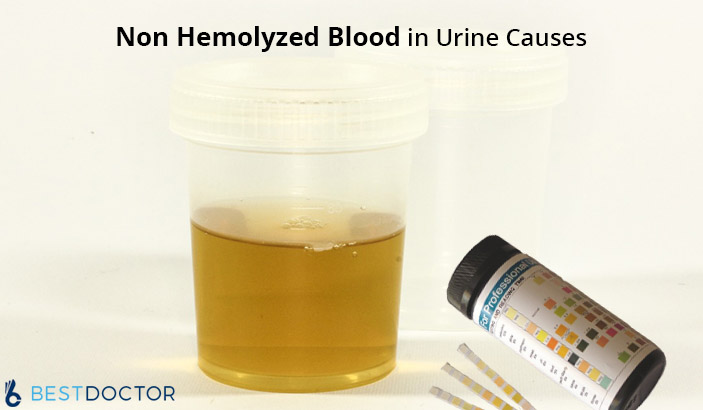What are Non Hemolyzed Blood in Urine Causes?
The presence of non-hemolyzed blood in urine means that there is some source of bleeding in the genitourinary tract. The non-hemolyzed blood in urine causes are many, and they can be diagnosed by an urologist or nephrologist by conducting various tests and looking for the cause for the blood in the urine.
Urine is the body’s liquid waste, which is mostly made of water, salts, and chemicals such as urea, uric acid, ammonia, hormones, and dead cells, proteins, salts, and certain minerals. Urine is made by the kidneys when they filter toxins and other harmful substances from the blood. Once it is made in the kidneys, the urine passes from the kidneys to the urinary bladder through a pair of muscular tubes called ureters, and when the bladder is full, it is expelled from the body through the urethra.
[Also read: Questions to ask doctor about kidney stones]
In normal conditions, urine does not have any odor or smells very little. If the urine has a strong odor, it may indicate dehydration, if the urine smells musty it may indicate a serious infection of the vagina or the urinary bladder, and if the urine smells of ammonia, it could mean chronic acidosis and this needs urgent medical attention.
The color and clarity of the urine also matter a lot, and normal urine is considered “clear,” if it appears cloudy, then it is a sign of a urinary infection. The normal color of urine is pale yellow, and if the urine appears dark yellow it may indicate dehydration. If the urine is orange or brown, it is an indication of dehydration coupled with liver stress or the presence of blood in urine. This condition needs medical evaluation to help find the cause for any disorder in the genitourinary tract.
If you notice any of these changes in urine, you may ask a doctor online before you consult or ask a nephrologist or urologist.
What Does Non-Hemolyzed Blood in Urine Mean?
The presence of non-hemolyzed blood in the urine is usually detected by a dipstick test. The dipstick forms a part of the urinalysis, a comprehensive test of the urine that checks for the physical appearance and the microscopic composition of urine. Urinalysis is usually done for the following reasons;
- To check for overall health of a patient and screen for disorders such as diabetes, liver or kidney diseases, and also to check for pregnancy
- To diagnose a medical condition if a patient shows symptoms such as abdominal pain, back pain, frequent or painful urination, or blood in the urine
- If you’ve been diagnosed with a disease related to the kidney or urinary tract, the urologist/ nephrologist may order a frequent urinalysis to monitor the condition.
The dipstick test forms the macroscopic part of the urinalysis, and sometimes the test results may be enough to diagnose a disease, but most often the dipstick test is accompanied by a microscopic examination of the urine sample to make a definite diagnosis of a kidney-related disease.
The main advantages of a dipstick test is that it is convenient, easy to interpret, and time-saving while also being cost-effective. The dipstick test evaluates various aspects of urine including:
- The pH
- The concentration
- Presence of sugar, ketones, bilirubin, blood, or protein in urine
- The evidence of any infection
A dipstick is a thin, plastic strip with strips of chemicals on it. The chemicals are present as several squares of different colors on the strip. The dipstick is dipped entirely in the urine sample of a patient, and the test results are interpreted by noting the color changes in each square on the strip. The color change on each specific square may indicate definite abnormalities in the urine sample caused by a certain chemical reaction. The presence of non-hemolyzed blood in the urine causes a change in a certain colored square on the dipstick, and it usually indicates the presence of fresh blood in the urine and may be caused by a kidney glomerular or urinary tract infection or kidney damage caused by hypertension. In females, it should be made sure that the urine in the blood is not due to menstruation. Additionally, non-hemolysed blood in the urine causes may be seen in pregnancy, and they are discussed later in the article.
Other Causes of Non-Hemolyzed Blood in Urine
The presence of non-hemolysed blood in urine indicates that the red blood cells have not undergone lysis and are present intact in blood. The presence of blood in urine is known as hematuria and it usually indicates a serious disorder. The blood may appear pink, red, or dark brown due to the presence of red blood cells (RBCs), and the urination may not be painful. Blood in the urine usually is not accompanied by any other signs or symptoms.
The non-hemolyzed blood in the urine causes commonly include;
- Urinary Tract Infections (UTIs): Urinary Tract Infections are caused by the entry of bacteria into the body through the urethra into the bladder where they multiply. The symptoms of UTI include frequent urination, pain or burning during urination, and foul-smelling urine.
- Kidney Infections: An infection of the kidneys is referred to as pyelonephritis, and is caused by the entry of bacteria into the kidneys from the blood stream or from the outside of the body through the urethra and their passage to the kidneys from the urethra through the ureters. Pyelonephritis presents with the same symptoms as UTIs and may sometimes cause fever and pain in the flanks.
- Kidney stones or bladder stones
- Enlarged prostate: This is usually common in middle-aged men and causes symptoms such as difficulty in urination, or an urgent or persistent need to urinate along with the presence of blood in the urine.
- Glomerulonephritis: This is an inflammation of the filtering system of the kidneys and it can either be caused by a systemic disease such as diabetes or can occur on its own.
- Advanced cancer of the kidneys, the urinary bladder, or the prostate gland
- Inherited conditions such as sickle cell anemia or the Alport Syndrome
- Any injury or trauma to the kidneys
- Certain medications may cause blood in urine trace, and these include anti-cancer drugs such as cyclophosphamide or penicillin and anticoagulants such as aspirin or blood thinners such as heparin.
Non-hemolyzed Blood in Urine During Pregnancy
The non-hemolyzed blood in urine causes during pregnancy may sometimes be due to bleeding of the cervix caused by lovemaking in the initial stages of pregnancy. However, it has to be investigated further because it could be a sign that the pregnant woman is in danger of a miscarriage. In the later stages of pregnancy, the presence of nonhemolyzed blood in urine can mean that the cervix is dilating and that labor may occur soon.
[cl-review quote=”Medically Reviewed By” author=”Dr. Kaushal M. Bhavsar (MBBS, MD)” occupation=”Assistant Professor in Pulmonary Medicine, GMERS Medical College, Ahmedabad” avatar_image=”1325″ source=”url:https%3A%2F%2Fwww.linkedin.com%2Fin%2Fdr-kaushal-bhavsar-a8137355%2F|target:_blank”]








16 Warning Signs You Need to Go See Your Doctor As Early As Possible
Gastroparesis: Symptoms, Causes, Diagnosis, Treatment, and Life Expectancy
Does Melatonin Help You Sleep? An In-Depth Analysis
Navigating Sexual Health Online: When to Consult a Sexologist